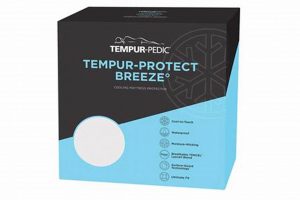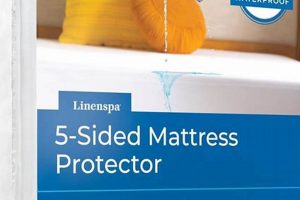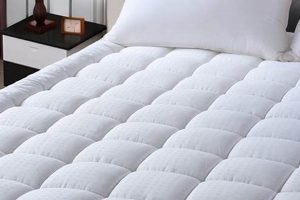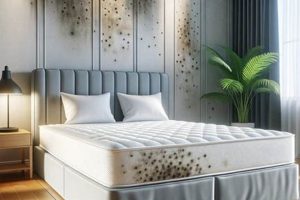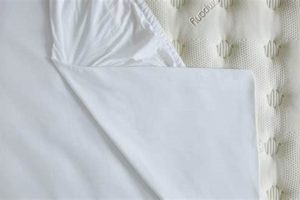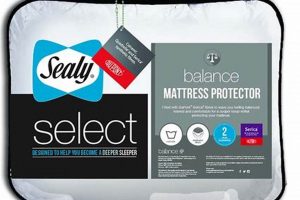A bedding item designed to shield a mattress from liquids and stains, while utilizing materials cultivated without synthetic pesticides, herbicides, or fertilizers, offers a protective layer. These items prevent moisture from penetrating the mattress, thus extending its lifespan and maintaining hygiene. They represent a growing trend toward healthier and more sustainable home goods.
The significance of employing such a protector lies in its dual benefits: safeguarding the mattress and promoting a healthier sleep environment. The barrier properties ensure the mattress remains free from allergens, dust mites, and mold growth, all of which can exacerbate respiratory issues. Furthermore, the use of organically sourced materials reduces exposure to potentially harmful chemicals often found in conventional bedding, aligning with increasing awareness of environmental and personal well-being. Historically, mattress protection focused primarily on functionality, but modern designs incorporate both performance and ecological considerations.
The subsequent sections will delve into the composition of these protective layers, examining the specific materials used, their certifications, and the factors to consider when selecting the most suitable option for individual needs. Detailed comparisons will also be presented, contrasting this type of bedding accessory with conventional alternatives, highlighting the distinctions in material sourcing, manufacturing processes, and overall environmental impact.
Guidance for Selecting and Maintaining Protective Bedding
The following guidelines provide practical advice for informed selection and optimal maintenance of a mattress shield designed to offer both water resistance and organic composition. Careful consideration of these factors can contribute to a healthier sleep environment and prolonged product lifespan.
Tip 1: Prioritize Certifications. Verify the presence of recognized organic certifications, such as GOTS (Global Organic Textile Standard) or Oeko-Tex Standard 100. These certifications ensure the materials meet stringent environmental and safety standards throughout the production process.
Tip 2: Examine Material Composition. Scrutinize the materials list. Look for natural fibers like organic cotton, wool, or bamboo, combined with a waterproof layer that is ideally free of PVC, phthalates, and other potentially harmful chemicals. Polyurethane is a common choice; investigate alternatives.
Tip 3: Assess Waterproofing Method. Understand how water resistance is achieved. Some protectors use tightly woven fabrics, while others employ a thin waterproof membrane. Evaluate the breathability of the chosen method to prevent overheating during sleep.
Tip 4: Consider Mattress Depth. Ensure the protector’s pocket depth corresponds to the thickness of the mattress. An improperly sized protector can slip off or fail to provide adequate coverage.
Tip 5: Review Washing Instructions. Adhere strictly to the manufacturer’s washing instructions. Improper laundering can compromise the waterproof barrier or damage the organic fibers. Gentle cycles and low heat drying are often recommended.
Tip 6: Avoid Harsh Chemicals. Refrain from using harsh detergents, bleach, or fabric softeners when washing the protector. These chemicals can degrade the materials and potentially release harmful substances.
Tip 7: Air Dry When Possible. While tumble drying may be convenient, air drying the protector can extend its lifespan and minimize shrinkage. Hang it in a well-ventilated area away from direct sunlight.
Adherence to these guidelines facilitates a well-informed purchase and contributes to the sustained performance and longevity of the chosen mattress shield. Selecting products with verified organic certification and meticulous care routines support both personal well-being and environmental responsibility.
The subsequent article sections will address common misconceptions associated with organic bedding and provide resources for identifying reputable suppliers.
1. Organic Material Sourcing
The origin of materials significantly impacts the overall value proposition of a mattress protector. In the context of a bedding item designed to prevent fluid ingress while adhering to organic standards, material sourcing becomes a critical determinant of environmental impact, user health, and product integrity.
- Certified Organic Cotton Cultivation
Organic cotton farming prohibits the use of synthetic pesticides, herbicides, and genetically modified seeds. This reduces the exposure of agricultural workers and the environment to harmful chemicals. The cotton used in an bedding accessory should be sourced from farms with valid organic certifications, demonstrating adherence to these practices and providing traceability throughout the supply chain.
- Natural Rubber Harvesting for Waterproof Layers
The waterproof layer often incorporates natural rubber derived from rubber trees. Sustainable harvesting practices are essential to minimize deforestation and preserve biodiversity in rubber-producing regions. Ethical sourcing ensures that tapping is done without damaging the trees and that workers are treated fairly.
- Wool Processing Without Harsh Chemicals
Wool, sometimes used in the batting or as a natural fire retardant, should be processed without harsh chemicals like chlorine. Organic wool processing maintains the integrity of the fibers and reduces the risk of allergic reactions. Proper washing techniques using biodegradable soaps minimize environmental pollution.
- Fair Trade Practices and Labor Standards
Sourcing practices should extend beyond environmental considerations to include fair trade principles and adherence to labor standards. Ensuring that workers involved in the cultivation, harvesting, and processing of materials receive fair wages and work in safe conditions is a fundamental aspect of responsible sourcing.
The selection of bedding accessory that prioritizes ethically and environmentally sound sourcing offers multiple benefits. It reduces the user’s exposure to potentially harmful chemicals, supports sustainable agricultural practices, and promotes fair labor standards. The credibility of these claims rests on transparent supply chains and verifiable certifications, enabling consumers to make informed purchasing decisions.
2. Waterproof Membrane Integrity
Waterproof membrane integrity represents a core functional attribute of an organic bedding article intended to safeguard a mattress. The effectiveness of such a protector hinges directly on the membrane’s ability to resist liquid penetration while simultaneously maintaining breathability and durability. Compromised integrity negates the primary purpose of the protector, rendering it incapable of preventing moisture damage to the mattress. For instance, a membrane with pinholes or weakened seams will allow spills and bodily fluids to seep through, fostering mold growth and allergen accumulation within the mattress core. This can directly impact sleep hygiene and overall health.
The materials employed in the waterproof membrane play a crucial role in determining its long-term performance. Thermoplastic polyurethane (TPU) films, for example, offer a balance of waterproofness, breathability, and flexibility, often considered preferable to polyvinyl chloride (PVC) due to the absence of phthalates. The manufacturing process further influences membrane integrity; advanced lamination techniques minimize delamination risks, extending the product’s useful life. Real-world applications, such as hospital settings where hygiene is paramount, underscore the importance of a reliable waterproof barrier. Failure in such environments can lead to cross-contamination and increased healthcare costs.
In summary, the integrity of the waterproof membrane is not merely a desirable feature, but a fundamental requirement for an bedding item to fulfill its intended function effectively. Sustained integrity depends on material selection, manufacturing quality, and appropriate care protocols. Understanding this connection allows consumers to make informed choices, selecting protectors designed to provide lasting protection and contribute to a healthier sleep environment. The ongoing challenge lies in developing and implementing membrane technologies that maximize both waterproof performance and environmental compatibility.
3. Breathability Performance
Breathability performance constitutes a critical attribute of a bedding item designed to be both liquid-resistant and composed of organically derived materials. The absence of adequate airflow through the protective layer precipitates an accumulation of moisture vapor generated by the human body during sleep. This, in turn, fosters an environment conducive to the proliferation of bacteria and fungi, potentially compromising mattress hygiene and negatively impacting sleep quality. Consequently, breathability performance serves as a key determinant of the overall effectiveness and suitability of a protector for prolonged use. For example, a protector fabricated with a non-breathable membrane, despite its waterproof capabilities, can lead to overheating and discomfort, disrupting sleep patterns and negating the benefits of organic materials. Conversely, a protector exhibiting sufficient breathability allows for the dissipation of moisture, maintaining a dry and comfortable sleep surface.
The achievement of optimal breathability within a waterproof barrier necessitates a careful selection of materials and manufacturing techniques. Micro-porous membranes, for instance, permit the passage of air and water vapor while effectively blocking liquid penetration. The density and weave of the organic fabric used in conjunction with the membrane also contribute significantly to breathability. Real-world examples demonstrate the practical implications of this balance. Individuals residing in humid climates or those prone to night sweats particularly benefit from protectors engineered with high breathability performance. Such protectors mitigate the risk of moisture buildup, reducing the likelihood of skin irritation and allergic reactions. Furthermore, the long-term integrity of the mattress itself is enhanced by preventing the absorption of moisture, thereby inhibiting mold growth and extending its lifespan.
In conclusion, breathability performance is inextricably linked to the functional efficacy and overall value of an bedding accessory. Neglecting this aspect compromises the protector’s ability to create a healthy and comfortable sleep environment. The challenge lies in developing and implementing innovative materials and construction methods that simultaneously maximize waterproof protection and breathability. A holistic approach, encompassing material selection, manufacturing processes, and user education, is essential to ensure that bedding protectors fulfill their intended purpose without sacrificing comfort or hygiene.
4. Allergen Barrier Properties
The capacity of an organic bedding item to function as an effective barrier against allergens represents a significant consideration for individuals with sensitivities. The ability to impede the passage of common allergens, such as dust mites, pet dander, and pollen, contributes directly to improved sleep hygiene and a reduction in allergic reactions. The design and material composition of such a protector are critical determinants of its effectiveness in this regard.
- Dust Mite Resistance
Dust mites, microscopic organisms that thrive in bedding, are a primary trigger for allergic reactions. A tightly woven fabric, often organic cotton, prevents these mites from penetrating the mattress. The protectors effectiveness relies on pore size; smaller pores block mites and their allergenic waste. Real-world implications include reduced sneezing, coughing, and skin irritation, particularly beneficial for asthma sufferers.
- Pet Dander Entrapment
Pet dander, consisting of microscopic flecks of skin shed by animals, can also induce allergic responses. An effective protector encases the mattress, preventing dander from accumulating within the fibers. This containment strategy minimizes airborne allergens, creating a healthier indoor environment. For pet owners, this represents a tangible benefit in managing allergy symptoms.
- Pollen Infiltration Prevention
Pollen, a seasonal allergen, can readily infiltrate bedding, triggering allergic rhinitis. A robust barrier prevents pollen grains from reaching the mattress core. This is especially relevant during peak pollen seasons, providing relief for allergy sufferers. The tightness of the weave, combined with the protective membrane, contributes to its efficacy.
- Mold Spore Mitigation
While primarily focused on waterproofing, the barrier function also mitigates mold spore accumulation. By preventing moisture penetration, the protector reduces the likelihood of mold growth within the mattress. This is crucial for maintaining a healthy sleep environment, as mold spores can trigger respiratory problems. Homes with high humidity levels particularly benefit from this aspect.
The combined effect of these allergen barrier properties significantly enhances the value of an bedding article, particularly when crafted from organic materials. The ability to reduce exposure to common allergens promotes improved sleep quality and minimizes the incidence of allergic reactions. Careful material selection and construction techniques are paramount in maximizing these benefits.
5. Maintenance Requirements
The longevity and efficacy of an organic bedding protector are directly correlated with adherence to specific maintenance protocols. Deviations from recommended care procedures can compromise the integrity of the organic materials and the functionality of the waterproof barrier, thereby diminishing the product’s lifespan and protective capabilities.
- Washing Frequency and Temperature
Frequent laundering is necessary to remove accumulated dust mites, allergens, and surface contaminants. However, excessive washing, or the use of high temperatures, can degrade organic fibers and delaminate the waterproof membrane. Adhering to the manufacturer’s recommended washing frequency and temperature, typically cold or lukewarm, is crucial for preserving the protector’s integrity. Disregarding these instructions can lead to premature wear and tear.
- Detergent Selection and Usage
Conventional detergents often contain harsh chemicals that can strip natural oils from organic cotton or damage the waterproof layer. Employing a mild, plant-based detergent, free from bleach and optical brighteners, is recommended. Overuse of detergent can also leave residue on the protector, potentially causing skin irritation. Following the detergent’s recommended dosage is essential for optimal cleaning without compromising material integrity.
- Drying Methods and Precautions
High heat from tumble dryers can shrink organic fibers and weaken the waterproof membrane. Air drying is the preferred method, although low-heat tumble drying may be acceptable if explicitly permitted by the manufacturer. Over-drying, regardless of the heat setting, should be avoided. Properly drying the protector is essential to prevent mold growth and maintain its protective function.
- Stain Removal Techniques
Prompt stain removal is vital to prevent permanent discoloration and potential damage to the protector. Spot cleaning with a mild, diluted cleaning solution is recommended for localized stains. Avoid using harsh chemicals or abrasive cleaners, as these can compromise the organic materials and waterproof barrier. Gently blotting the stain, rather than rubbing, minimizes the risk of fiber damage and maintains the protector’s appearance.
These maintenance requirements are not merely suggestions but essential guidelines for preserving the functional and aesthetic qualities of an organic waterproof mattress protector. Strict adherence to these protocols ensures that the protector continues to provide a safe, healthy, and hygienic sleep environment while maximizing its lifespan and overall value.
6. Certification Verification
In the realm of bedding products, specifically those marketed as an bedding accessory, certification verification serves as a crucial mechanism for ensuring the veracity of claims regarding organic material content and waterproof functionality. This process offers consumers a degree of assurance that the product aligns with established standards and regulatory requirements.
- GOTS (Global Organic Textile Standard) Certification
GOTS certification represents a stringent assessment of the entire textile supply chain, from raw material cultivation to finished product manufacturing. For an organic bedding accessory, this certification verifies that the cotton, wool, or other natural fibers used meet specific criteria regarding organic farming practices, chemical inputs, and social responsibility. The presence of a GOTS label indicates adherence to internationally recognized standards, minimizing the risk of misleading claims about organic content. A product lacking GOTS certification raises concerns regarding the authenticity of its organic attributes.
- OEKO-TEX Standard 100 Certification
While not exclusively focused on organic materials, OEKO-TEX Standard 100 certification tests for harmful substances in textiles. This certification is relevant to an bedding accessory as it ensures that the product, including the waterproof membrane and any dyes or finishes, is free from potentially allergenic or carcinogenic chemicals. The presence of an OEKO-TEX label provides assurance that the product meets human-ecological requirements, safeguarding consumers from exposure to hazardous substances. A product failing to meet OEKO-TEX standards may pose health risks, particularly for sensitive individuals.
- Waterproof Performance Standards
Certifications specifically related to waterproof performance, such as those from independent testing laboratories, validate the protector’s ability to prevent liquid penetration. These certifications often involve standardized tests simulating real-world conditions, ensuring the protector effectively safeguards the mattress from spills and stains. The absence of waterproof performance certification raises doubts about the product’s functional claims. A product without verifiable waterproof capabilities fails to fulfill its primary purpose, potentially leading to mattress damage and hygiene concerns.
- Third-Party Verification Bodies
The credibility of certifications relies on the independence and impartiality of the verification bodies. Reputable certification organizations employ rigorous auditing processes and maintain transparency in their assessment methods. Consumers should research the certifying body to ensure its legitimacy and adherence to established standards. A certification from an unrecognized or disreputable organization provides little assurance of product quality or compliance.
In summary, certification verification serves as a cornerstone of trust and transparency in the market for organically-derived, waterproof mattress protectors. The presence of valid certifications, from reputable organizations, offers consumers a means of validating product claims and mitigating the risk of deceptive marketing practices. Thorough due diligence, including verification of certification credentials, is essential for making informed purchasing decisions and ensuring the product aligns with stated environmental and functional attributes.
Frequently Asked Questions About Organic Waterproof Mattress Protectors
The following section addresses common inquiries and clarifies misconceptions surrounding the selection, usage, and maintenance of bedding accessories designed to provide liquid resistance while adhering to organic material standards.
Question 1: Are all mattress protectors labeled “organic” truly composed of organically sourced materials?
No. The term “organic” is subject to varying interpretations and levels of regulation. To ensure authenticity, verify the presence of recognized certifications such as GOTS (Global Organic Textile Standard) or OEKO-TEX Standard 100. These certifications indicate independent verification of organic material content and the absence of harmful substances.
Question 2: How does an product achieve both waterproof functionality and breathability?
The simultaneous attainment of waterproofness and breathability is typically achieved through the utilization of a micro-porous membrane. This membrane contains microscopic pores that permit the passage of air and water vapor while preventing the ingress of liquids. Material composition and manufacturing techniques significantly influence the performance of this membrane.
Question 3: Does the use of an bedding accessory eliminate the need for regular mattress cleaning?
No. While an bedding accessory provides a protective barrier, it does not obviate the need for periodic mattress cleaning. Regular vacuuming of the mattress surface is recommended to remove dust mites, allergens, and debris that may accumulate over time. Professional mattress cleaning may also be warranted periodically.
Question 4: Can an bedding protector effectively prevent bed bug infestations?
An bedding accessory can serve as a preventative measure against bed bug infestations by encasing the mattress and eliminating potential harborage sites. However, it is not a complete solution. Vigilance in identifying and addressing potential infestations is crucial. The protector should be specifically designed to be bed bug-proof, with tightly sealed seams and a durable encasement.
Question 5: How does the lifespan of an compare to that of a conventional mattress protector?
The lifespan of an bedding accessory is influenced by various factors, including material quality, construction techniques, and maintenance practices. In general, protectors crafted from high-quality organic materials and maintained according to manufacturer instructions can exhibit comparable or even superior longevity compared to conventional protectors.
Question 6: Is there a significant price difference between an bedding article and a conventional alternative?
Yes. Protectors crafted from organically sourced materials typically command a higher price point compared to conventional alternatives. This price differential reflects the increased cost associated with organic farming practices, sustainable manufacturing processes, and certification requirements. The long-term value proposition should be considered when evaluating this price difference.
In summation, a comprehensive understanding of the factors outlined above is essential for making informed decisions regarding the selection, usage, and maintenance of bedding accessories designed to provide liquid resistance while adhering to organic material standards.
The subsequent article sections will provide resources for locating reputable suppliers of certified organic bedding protectors and address advanced topics related to material science and manufacturing innovations.
Organic Waterproof Mattress Protector
This exploration has underscored the multifaceted nature of the organic waterproof mattress protector. It has illuminated the significance of material sourcing, the performance demands of waterproof membranes, the criticality of breathability, and the essential role of allergen barrier properties. Further, it has emphasized the importance of adherence to specific maintenance requirements and the necessity of verifying certifications to ensure product authenticity and compliance with established standards.
The information presented serves to empower informed decision-making regarding this essential bedding item. The pursuit of a sleep environment that prioritizes both hygiene and well-being necessitates a careful consideration of the factors outlined herein. Selecting a protector that effectively balances these attributes contributes to a healthier and more sustainable lifestyle, underscoring its enduring significance in the realm of domestic textiles.


